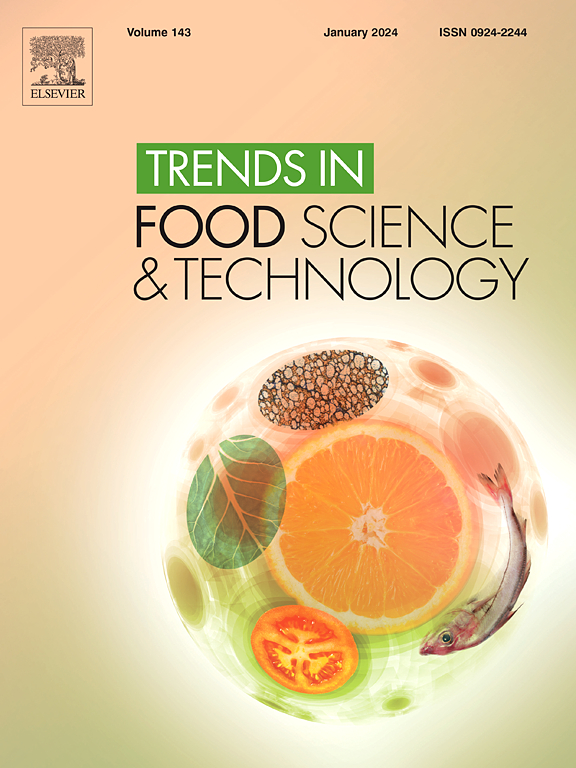Multidimensional exploration of the interactions and mechanisms between fat and salt: Saltiness perception, and taste perception and oxidation of fat
IF 15.1
1区 农林科学
Q1 FOOD SCIENCE & TECHNOLOGY
引用次数: 0
Abstract
Background
The combination of fat and salt is widely applied in foods. However, understanding the correlation and the mechanism between the two is an important prerequisite for the development of low-fat and low-salt foods.
Scope and approach
The synergy of fat and salt, the relationship between the two and correlation mechanism, and available mathematical statistical-tools to explore their relationship were reviewed.
Key findings and conclusions
Fat influences saltiness perception through three primary mechanisms: modulating effective salt concentration, altering food texture, and interacting with taste receptors, with effects varying by food matrix. Salt affects fat in terms of fat-taste perception and oxidation. The regulation mechanism of salt on fat-taste perception is not clear. Fat-taste perception and saltiness perception involve cross-modal interactions between taste receptors and neural signaling pathways. The principle that salt promotes or inhibits fat oxidation is mainly related to characteristics of food systems (water activity, pH, etc.), catalytic ability of metal ions, and redox balance of pro-/antioxidants. Salt can indirectly affect fat-taste perception by influencing fat oxidation, which mainly involves the destruction of structure and physicochemical properties of oxidized-fat, the masking effect of oxidized-products and their interference on taste-receptors. Correlation analysis, regression analysis, partial least squares regression analysis, principal component analysis and deep learning have been used to investigate the relationship between fat and salt. Next, cutting-edge methods such as gene editing technology and high-resolution neural imaging are needed to deeply analyze the interaction details between taste-receptors for saltiness and fat-taste, as well as between their neural signals.
脂肪和盐之间相互作用和机制的多维探索:咸味感知、味觉感知和脂肪氧化
脂肪和盐的组合在食品中应用广泛。然而,了解两者之间的相关性和机制是开发低脂低盐食品的重要前提。范围和方法综述了脂肪和盐的协同作用、两者之间的关系和相关机制,以及现有的数理统计工具来探讨它们之间的关系。主要发现和结论脂肪通过三种主要机制影响咸味感知:调节有效盐浓度,改变食物质地,与味觉受体相互作用,其作用因食物基质而异。盐会影响脂肪的味觉感知和氧化。盐对脂肪味觉的调节机制尚不清楚。脂味感知和咸味感知涉及味觉受体和神经信号通路之间的跨模态相互作用。盐促进或抑制脂肪氧化的原理主要与食物体系的特性(水活度、pH值等)、金属离子的催化能力以及前/抗氧化剂的氧化还原平衡有关。盐通过影响脂肪氧化间接影响脂肪味觉,主要包括对氧化脂肪结构和理化性质的破坏、氧化产物的掩蔽作用及其对味觉感受器的干扰。相关分析、回归分析、偏最小二乘回归分析、主成分分析和深度学习已被用于研究脂肪和盐之间的关系。接下来,需要基因编辑技术和高分辨率神经成像等尖端方法来深入分析咸味和脂肪味味觉受体之间以及它们的神经信号之间的相互作用细节。
本文章由计算机程序翻译,如有差异,请以英文原文为准。
求助全文
约1分钟内获得全文
求助全文
来源期刊

Trends in Food Science & Technology
工程技术-食品科技
CiteScore
32.50
自引率
2.60%
发文量
322
审稿时长
37 days
期刊介绍:
Trends in Food Science & Technology is a prestigious international journal that specializes in peer-reviewed articles covering the latest advancements in technology, food science, and human nutrition. It serves as a bridge between specialized primary journals and general trade magazines, providing readable and scientifically rigorous reviews and commentaries on current research developments and their potential applications in the food industry.
Unlike traditional journals, Trends in Food Science & Technology does not publish original research papers. Instead, it focuses on critical and comprehensive reviews to offer valuable insights for professionals in the field. By bringing together cutting-edge research and industry applications, this journal plays a vital role in disseminating knowledge and facilitating advancements in the food science and technology sector.
 求助内容:
求助内容: 应助结果提醒方式:
应助结果提醒方式:


